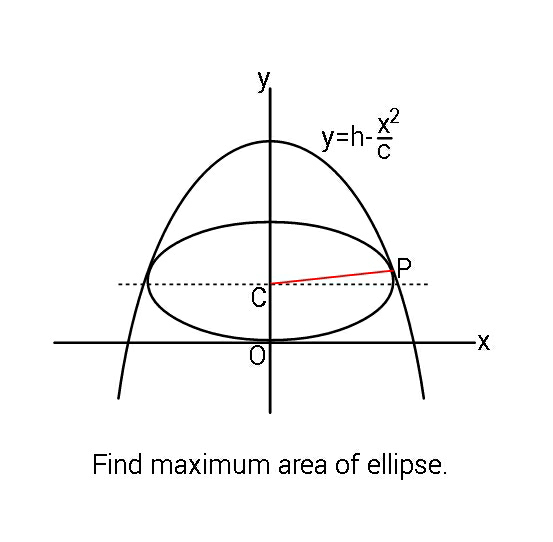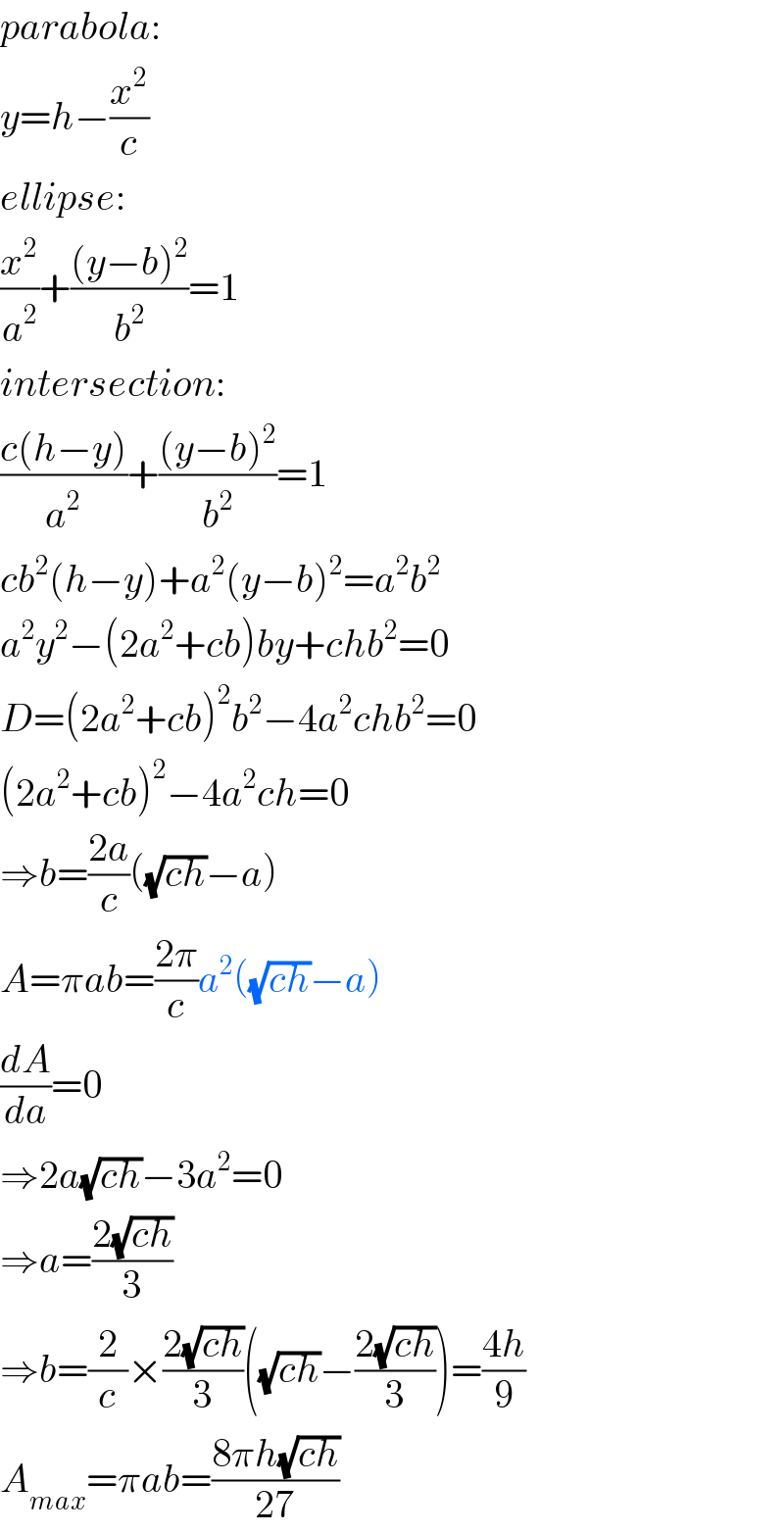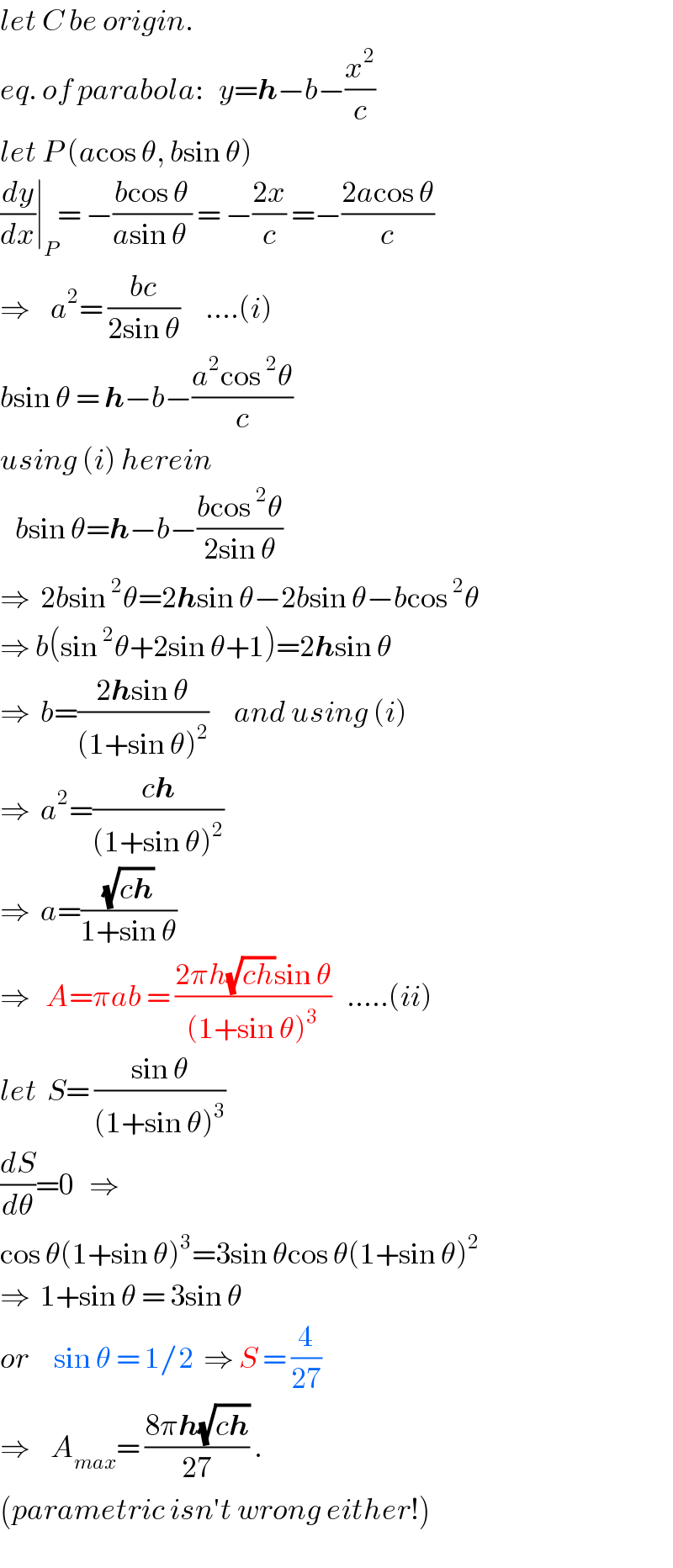Question Number 54242 by ajfour last updated on 01/Feb/19

Answered by mr W last updated on 01/Feb/19

$${parabola}: \\ $$$${y}={h}−\frac{{x}^{\mathrm{2}} }{{c}} \\ $$$${ellipse}: \\ $$$$\frac{{x}^{\mathrm{2}} }{{a}^{\mathrm{2}} }+\frac{\left({y}−{b}\right)^{\mathrm{2}} }{{b}^{\mathrm{2}} }=\mathrm{1} \\ $$$${intersection}: \\ $$$$\frac{{c}\left({h}−{y}\right)}{{a}^{\mathrm{2}} }+\frac{\left({y}−{b}\right)^{\mathrm{2}} }{{b}^{\mathrm{2}} }=\mathrm{1} \\ $$$${cb}^{\mathrm{2}} \left({h}−{y}\right)+{a}^{\mathrm{2}} \left({y}−{b}\right)^{\mathrm{2}} ={a}^{\mathrm{2}} {b}^{\mathrm{2}} \\ $$$${a}^{\mathrm{2}} {y}^{\mathrm{2}} −\left(\mathrm{2}{a}^{\mathrm{2}} +{cb}\right){by}+{chb}^{\mathrm{2}} =\mathrm{0} \\ $$$${D}=\left(\mathrm{2}{a}^{\mathrm{2}} +{cb}\right)^{\mathrm{2}} {b}^{\mathrm{2}} −\mathrm{4}{a}^{\mathrm{2}} {chb}^{\mathrm{2}} =\mathrm{0} \\ $$$$\left(\mathrm{2}{a}^{\mathrm{2}} +{cb}\right)^{\mathrm{2}} −\mathrm{4}{a}^{\mathrm{2}} {ch}=\mathrm{0} \\ $$$$\Rightarrow{b}=\frac{\mathrm{2}{a}}{{c}}\left(\sqrt{{ch}}−{a}\right) \\ $$$${A}=\pi{ab}=\frac{\mathrm{2}\pi}{{c}}{a}^{\mathrm{2}} \left(\sqrt{{ch}}−{a}\right) \\ $$$$\frac{{dA}}{{da}}=\mathrm{0} \\ $$$$\Rightarrow\mathrm{2}{a}\sqrt{{ch}}−\mathrm{3}{a}^{\mathrm{2}} =\mathrm{0} \\ $$$$\Rightarrow{a}=\frac{\mathrm{2}\sqrt{{ch}}}{\mathrm{3}} \\ $$$$\Rightarrow{b}=\frac{\mathrm{2}}{{c}}×\frac{\mathrm{2}\sqrt{{ch}}}{\mathrm{3}}\left(\sqrt{{ch}}−\frac{\mathrm{2}\sqrt{{ch}}}{\mathrm{3}}\right)=\frac{\mathrm{4}{h}}{\mathrm{9}} \\ $$$${A}_{{max}} =\pi{ab}=\frac{\mathrm{8}\pi{h}\sqrt{{ch}}}{\mathrm{27}} \\ $$
Commented by ajfour last updated on 01/Feb/19

$$\mathcal{THANK}\:\mathcal{YOU}\:\:\mathbb{SIR}. \\ $$
Answered by ajfour last updated on 01/Feb/19

$${let}\:{C}\:{be}\:{origin}. \\ $$$${eq}.\:{of}\:{parabola}:\:\:\:{y}=\boldsymbol{{h}}−{b}−\frac{{x}^{\mathrm{2}} }{{c}} \\ $$$${let}\:{P}\:\left({a}\mathrm{cos}\:\theta,\:{b}\mathrm{sin}\:\theta\right) \\ $$$$\frac{{dy}}{{dx}}\mid_{{P}} =\:−\frac{{b}\mathrm{cos}\:\theta}{{a}\mathrm{sin}\:\theta\:}\:=\:−\frac{\mathrm{2}{x}}{{c}}\:=−\frac{\mathrm{2}{a}\mathrm{cos}\:\theta}{{c}} \\ $$$$\Rightarrow\:\:\:\:{a}^{\mathrm{2}} =\:\frac{{bc}}{\mathrm{2sin}\:\theta}\:\:\:\:\:….\left({i}\right) \\ $$$${b}\mathrm{sin}\:\theta\:=\:\boldsymbol{{h}}−{b}−\frac{{a}^{\mathrm{2}} \mathrm{cos}\:^{\mathrm{2}} \theta}{{c}} \\ $$$${using}\:\left({i}\right)\:{herein} \\ $$$$\:\:\:{b}\mathrm{sin}\:\theta=\boldsymbol{{h}}−{b}−\frac{{b}\mathrm{cos}\:^{\mathrm{2}} \theta}{\mathrm{2sin}\:\theta} \\ $$$$\Rightarrow\:\:\mathrm{2}{b}\mathrm{sin}\:^{\mathrm{2}} \theta=\mathrm{2}\boldsymbol{{h}}\mathrm{sin}\:\theta−\mathrm{2}{b}\mathrm{sin}\:\theta−{b}\mathrm{cos}\:^{\mathrm{2}} \theta \\ $$$$\Rightarrow\:{b}\left(\mathrm{sin}\:^{\mathrm{2}} \theta+\mathrm{2sin}\:\theta+\mathrm{1}\right)=\mathrm{2}\boldsymbol{{h}}\mathrm{sin}\:\theta \\ $$$$\Rightarrow\:\:{b}=\frac{\mathrm{2}\boldsymbol{{h}}\mathrm{sin}\:\theta}{\left(\mathrm{1}+\mathrm{sin}\:\theta\right)^{\mathrm{2}} }\:\:\:\:\:{and}\:{using}\:\left({i}\right) \\ $$$$\Rightarrow\:\:{a}^{\mathrm{2}} =\frac{{c}\boldsymbol{{h}}}{\left(\mathrm{1}+\mathrm{sin}\:\theta\right)^{\mathrm{2}} } \\ $$$$\Rightarrow\:\:{a}=\frac{\sqrt{{c}\boldsymbol{{h}}}}{\mathrm{1}+\mathrm{sin}\:\theta}\:\:\: \\ $$$$\Rightarrow\:\:\:{A}=\pi{ab}\:=\:\frac{\mathrm{2}\pi{h}\sqrt{{ch}}\mathrm{sin}\:\theta}{\left(\mathrm{1}+\mathrm{sin}\:\theta\right)^{\mathrm{3}} }\:\:\:…..\left({ii}\right) \\ $$$${let}\:\:{S}=\:\frac{\mathrm{sin}\:\theta}{\left(\mathrm{1}+\mathrm{sin}\:\theta\right)^{\mathrm{3}} } \\ $$$$\frac{{dS}}{{d}\theta}=\mathrm{0}\:\:\:\Rightarrow \\ $$$$\mathrm{cos}\:\theta\left(\mathrm{1}+\mathrm{sin}\:\theta\right)^{\mathrm{3}} =\mathrm{3sin}\:\theta\mathrm{cos}\:\theta\left(\mathrm{1}+\mathrm{sin}\:\theta\right)^{\mathrm{2}} \\ $$$$\Rightarrow\:\:\mathrm{1}+\mathrm{sin}\:\theta\:=\:\mathrm{3sin}\:\theta \\ $$$${or}\:\:\:\:\:\mathrm{sin}\:\theta\:=\:\mathrm{1}/\mathrm{2}\:\:\Rightarrow\:{S}\:=\:\frac{\mathrm{4}}{\mathrm{27}}\:\:\: \\ $$$$\Rightarrow\:\:\:\:{A}_{{max}} =\:\frac{\mathrm{8}\pi\boldsymbol{{h}}\sqrt{{c}\boldsymbol{{h}}}}{\mathrm{27}}\:. \\ $$$$\left({parametric}\:{isn}'{t}\:{wrong}\:{either}!\right) \\ $$
Commented by mr W last updated on 01/Feb/19

$${nice}\:{too}! \\ $$
